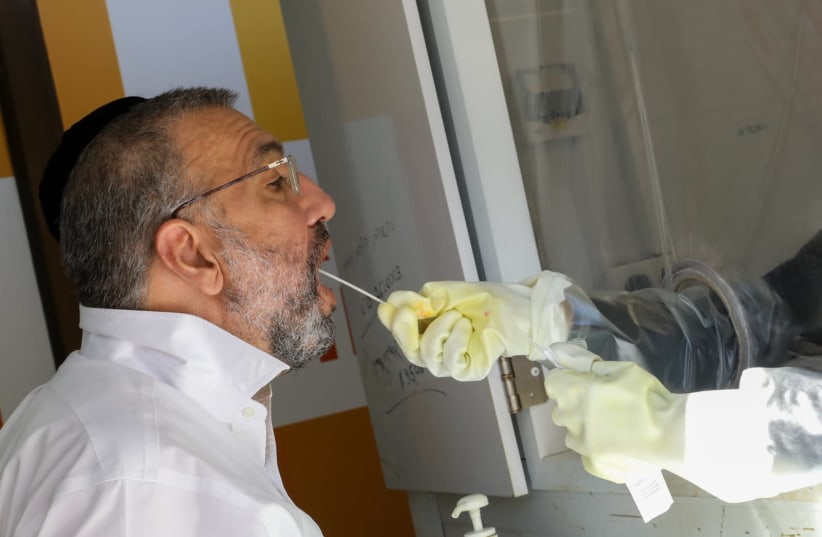Israel’s coronavirus reproductive rate (R-rate) is on the rise again, reaching 0.95 for the first time since late March. The coronavirus R-rate refers to the number of people that each person with COVID-19 will infect on average, meaning that once it is above one, the spread of the virus will rapidly pick up pace.
Does this mean that there is a reason to worry?
Although the R-rate has already reached 0.95, it has not hit the crucial 1.0 mark, meaning that as of yet, there is no reason for immediate concern. However, the speed at which it is rising might indicate that it will hit one in the coming days, and only increase from there.
As there is currently no new variant of concern, it is highly unlikely that the numbers will spike dramatically. It is instead more likely that localized outbreaks are occurring across the country. Independence Day was celebrated only last week, and it is entirely possible that the sudden spike in the R-rate is due to large celebrations held across the country.
Numbers remain low but inaccurate

When looking at the daily coronavirus statistics, it is easy to feel as though the disease is behind us. However, for the last few months, the numbers have gotten less and less accurate as more and more people have stopped taking authorized PCR and antigen tests. Instead, many have turned to the rapid at-home antigen tests, which provide quick results. Upon receiving a positive result, people, especially those with symptoms who feel unwell, will not then make the trip to a government testing station to verify what they already know.
As a result, there is no real way of knowing how many people have COVID-19 at any one time, although it is safe to assume the number is far higher than what is being reported.
For example, although only 2,086 new coronavirus cases were recorded on Thursday, only 53,031 authorized PCR and antigen tests were taken. Because of the lack of accurate data available, it is much harder to know whether or not this low number is accurate, or whether the number of infected people is rising without us even knowing.
However, back in April, the number of tests being taken was similar to what can be seen today – around 50,000-55,000 daily authorized COVID-19 tests. And yet, the reported number of infections was almost doubled, at around 4,000 a day. This can give us a more accurate understanding of the numbers we are seeing now. Even though they are not entirely accurate, the number of tests being taken daily is more or less consistent, allowing us to see that the infection is likely to be lower now than it was this time last month.
Even if numbers are rising, serious cases have not
ONE OF THE main causes of concern during a large COVID-19 outbreak is the impact that it will have on a country’s healthcare system. At the peak of Israel’s Omicron wave, more than 1,200 people were reported as being in serious condition, and multiple hospitals across the country were operating either at or above capacity.
However, that is not the case now, nor is it even anywhere close to being the case. There are currently 110 serious COVID-19 patients here, with 51 of them intubated and another five connected to ECMO machines. Even if localized outbreaks are occurring within the country, they have not led to a serious increase of hospital cases, meaning that the health system can continue operating as normal without worry of another imminent overload.
The impact of tourism
The new rules at Ben-Gurion Airport, which allow travelers to forgo a PCR test upon arrival, only take effect on May 20, and it is possible that this decision will bring an increased number of cases and a faster spread of the disease into the country.
In recent days and weeks, several countries, most notably the US, have reported an uptick in COVID-19 cases. Furthermore, North Korea reported coronavirus cases inside the country on Thursday for the first time since the start of the pandemic.
If the virus is on the rise again, to the extent that it can reach the largely isolated country of North Korea, it is entirely possible that numerous new cases will be able to slip through into Israel undetected, causing an increase in cases.
What do medical professionals think?
The new surge in COVID-19 cases, including those in Israel, is not going unnoticed by doctors and medical staff.
On Tuesday of this week, a team of experts from John Hopkins University released a statement saying, “In the short term, this new surge [in cases] is not expected to be as severe as previous waves.” However, they cautioned, this could still change.
As with other COVID-19 waves, first the number of cases starts to rise, and then the number of hospitalizations follows. Finally, the number of deaths starts to increase, explained one member of the team, infectious disease epidemiologist Dr. David Dowdy.
However, he added, there is not yet reason to worry. The average cases of COVID-19 are getting milder as time goes on.
“This is probably more because we as a population are building up the immunity,” said Dowdy, “not because the variants are necessarily getting milder on their own.”
Touching on the topic of inaccurate case numbers due to home testing, Dowdy acknowledged that it is a problem, as it gives epidemiologists less to work with.
“Hospitalizations are not perfect but are certainly better than case counts now. Death rates are still useful, but a lagging indicator,” he said, adding that more unconventional methods like wastewater surveillance can also help monitor pandemic trends.
“None of them are perfect, but when they’re all trending up together, we can get a sense that there’s a new wave coming,” Dowdy concluded.
